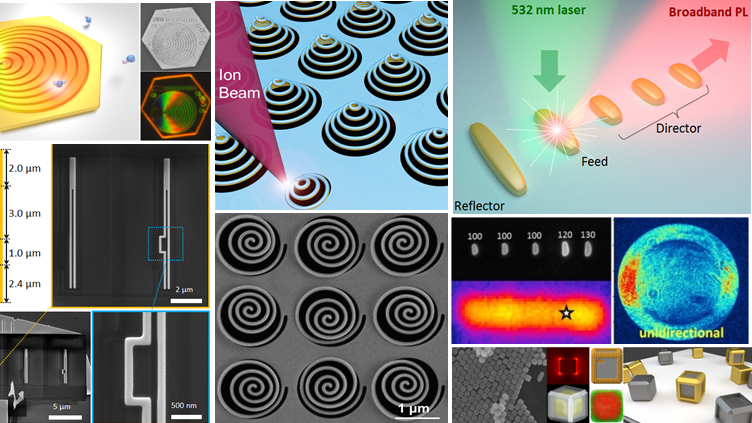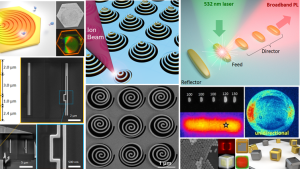
PD Dr. habil. Jer-Shing Huang, Leibniz-IPHT
Image: Sven Döring, IPHT Jena.PD Dr. habil. Jer-Shing HUANG
Email: jer-shing.huang@leibniz-ipht.de
Phone: +49-3641-206404
Dr. Jer-Shing Huang is the head of the Research Department of Nanooptics at the Leibniz Institute of Photonic Technology (Leibniz-IPHT). He is also an adjunct professor at the Department of Electrophysics at National Chiao Tung University (NCTU) and an adjunct research fellow at the Research Center for Applied Sciences (RCAS) at the Academia Sinica in Taiwan. Before 2016, he was an associate professor at the Department of Chemistry of National Tsing Hua University in Taiwan. He is a member of the Editorial Advisory Board of ACS Photonics and SPIE Visiting Lecturer.
The research group focuses on the understanding and engineering of nanoscale light-matter interaction by applying well-designed nanostructures. In particular, we are interested in the UV to near IR spectral window because the energy of photons in this regime is sufficiently large to promote electronic transition in matter. Our approach is as follows: We first perform theoretical analysis and numerical simulations to obtain optimal design of functional nanostructures for specific applications. The designed nanostructures are then realized by state-of-the-art modern nanotechnology, such as electron-beam lithography and focused-ion beam milling. The optical responses of the fabricated nanostructures are characterized using linear and nonlinear microscopic and spectroscopic methods. The experimental results are compared with theoretical models in order to optimize the design. With this approach, we aim at a full control over the properties of light at the nanoscale.
Research Areas
Dr. Huang’s research focuses on the engineering of nanoscale optical fields and light-matter interactions. The research is based on fundamental sciences in physics and chemistry, and extends to interdisciplinary applications in the fields of optics, spectroscopy, microscopy, materials sciences, and sensors. Current research topics include:
- Nanoantennas and nanocircuits
- Optical trapping
- Chiral spectroscopy and imaging
- Plasmonic nanosensors
- DNA origami-based plasmonic devices
- Fluorescent polymer micro-resonators
Teaching Fields
Dr. Huang’s teaching covers basic and advanced topics for graduate students to gain sufficient knowledge in light-matter interaction. Dr. Huang’s courses include:
- Physical chemistry
- Analytical chemistry
- Instrumental analysis
- Light-matter interaction
Research Methods
Dr. Huang’s research group exploits modern computer simulations and nanotechnology to design and fabricate high-definition nanostructures and applies linear and nonlinear microscopic and spectroscopic methods to characterize the optical response of the nanostructures and study the interaction between light and matter. Specific research methods include:
- Numerical simulations (COMSOL and FDTD Solutions)
- Microscopy and spectroscopy
- E-beam lithography and focused-ion beam milling
- Scanning electron and atomic force microscopy
- PL and dark-field scattering spectroscopy
- Circular-dichroism spectroscopy
- Evanescent-wave cavity ring-down spectroscopy
placeholder image — Stylized representation of a film projector
Graphic: FreepikFigure 1. Graphical summary of selected research results.
Graphic: Research group of Jer-Shing Huang.Recent Research Results
The interaction between light and matter is usually limited by the size mismatch between light wavelength and molecular size in the matter. The goal of Dr. Jer-Shing Huang’s group is to understand, control, and utilize nanoscale light-matter interactions through the application of rationally designed nanostructures. In particular, the group focuses on nanoplasmonics, which studies and controls the fundamental processes of the interaction of light with matter at the nanoscale. Fields of application include the sensitive detection of molecular chirality, nanoscale integrated optical circuits, plasmon-enhanced spectroscopy, and nanoobjects manipulation by the optical field. For optical nanosensors, we have developed a spectrometer-free plasmonics sensing platform, the plasmonic Doppler grating (PDG) [1]. A PDG consists of a series of circular grooves on a gold film that mimics the wavefront of a moving point source exhibiting the Doppler effect. We demonstrate PDG’s ultimate sensitivity for direct quantification of the peculiar and tiny refractive index enhancement due to hydrogen bonds in water-ethanol mixtures. The PDG has also been applied to spatially resolve the plasmonic enhancement effect in coherent anti-Stokes Raman scattering [2]. Another type of optical nanosensors are based on bottom-up chemically synthesized nanoparticles. For example, we prepared high-definition bimetallic Au−Pd−Au nanobricks as an archetype of robust nanoplasmonic hydrogen sensors. We achieved the highest spectral shift of the resonance peak upon the absorption of hydrogen gas at a very low concentration [3]. For optical nanocircuits, we developed, for the first time, deep sub-wavelength mode conversion at the frequency of 194 THz (vacuum wavelength =1,545 nm). The field is confined into a nanogap with a width of only λ/15 of the operational optical signals. We show that by controlling the symmetry of the fundamentals modes in the waveguide, second-harmonics can be effectively generated in a centrally symmetric structure made of gold materials. [4]. Regarding chiral light-matter interaction, we have developed a one-step nanofabrication method to effectively fabricate a metasurface consisting of 3D chiral units, which exhibit superior chiral dissymmetry, stable field localization, and broadband near-field optical chirality [5]. We also study the generation of optical chirality patterns using interference of far-field beam and plasmonic waves [6]. These optical chirality patterns have many potential applications including super-resolution chiral imaging [7]. The figure shows the representative images from the mentioned research projects.
[1] Lin et al., Anal. Chem. 91, 9382 (2019).
[2] Ouyang et al., ACS Nano doi:10.1021/acsnano.0c07198 (2021).
[3] Ng et al., Chem. Mater. 30, 204 (2018).
[4] Chen et al., Nano Lett. 19, 6424 (2019).
[5] Tseng et al., Adv. Opt. Mater. 7, 1900617 (2019).
[6] Zhang et al., Opt. Express 28, 760 (2020).
[7] Huang et al., ACS Photon. 8, 130 (2021).
Link to Nanoplasmonics Group at the Leibniz Institute of Photonic TechnologyExternal link

